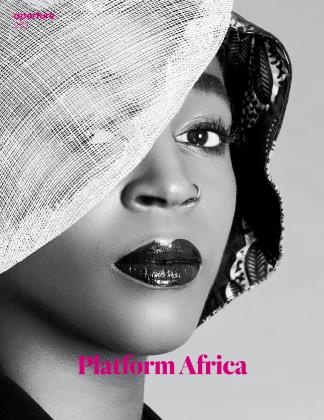SABELO MLANGENI BIG CITY
Bongani Madondo
PICTURES
There’s something achingly poetic and yet unsettling about Sabelo Mlangeni’s work. This paradox is a reflection of the Johannesburg-based photographer’s approach: a soul quite quiet, though audible in its silence. Because of this innate calm, Mlangeni succeeds in taking both subjects and audience into his confidence. A Zen-like trait gifts his work with a sense of welcoming reassurance.
On the other hand, his images convey a deeply satisfying, even ugly-beauty sensibility that is ultimately autobiographical. Their realism and presence are entrenched in Mlangeni’s reluctance to press your face against the pulse of the city where he walks and shoots.
There’s also something raw yet elegant here. Raw as in unfinished, although you cannot tell what exactly is missing. And the elegance of composition. The minimalist knack of uncluttering an already miasmic African megalopolis, Johannesburg, a place for which he nurses something of an intense love and hate.
Mlangeni first arrived in the big city in 2001, age twenty-one, raw from the woods, a place named Wakkerstroom ("awake ravine”), bordering the fabled republic of the Zulus, KwaZulu-Natal, and the equally proud Swazi kingdom. His only experience in photography was less than an assistant, more like a busboy, in the ramshackle studio of a village photographer, Mrs. C. S. Mavuso. In addition to cleaning up the studio for her, he ran on foot delivering postcard-style "snaps” to clients and collecting payments.
In Johannesburg, alienated and scared, he found home at the Market Photo Workshop, where he enrolled in an intermediate course—a thirteen-week introduction to photography that takes neophyte photographers through the basics of visual literacy and methodology, and offers them the use of equipment and in-house resources. But his enrollment in the workshop, thus his introduction to the city, did not quite translate into understanding the dynamics of the big city.
"A shock and shot to my system,” he says, as both of us are hanging out the window ledge of his flat in the Johannesburg inner city, overlooking the streets of the place he has since reluctantly called home.
Johannesburg, then and now, is Africa’s economic hub, a behemoth African bazaar, the nexus at which an exploding continental otherworldliness and a saturation of pan-African pavement capitalism smooch first-world architecture. The results throw up a city held thinly together by the ethos of convenience and active, almost punk-like dissonance.
Mlangeni recalls how his reception into urban life played out: "It was my first time ever in a city, let alone a city as improbably immense as Johannesburg. First time in a city, first time in this city, first time in a photography school.” He struggled with everything. He struggled with English. He struggled with building friendships. "Everyone sounded like they were speaking in tongues. I could not communicate. I felt like an alien in the big city. So I turned my camera onto the buildings. The architecture.”
His early photographs—like Eugene Atget’s, a commentary on architecture as a site of both rapture and roots—focus on the city’s contrast between constant rebuilding and retaining aspects of its past. Everywhere he went, new buildings were constructed on sites of existing ones, sometimes demolishing the old, but often having the old side by side with the new. Johannesburg Circa Now, an exhibition curated by Jo Ractliffe and Terry Kurgan, in 2004, featured Mlangeni’s observations of urban life. "From then on I started looking at Johannesburg as a non-home.” That sense of alienation served as the building blocks for Big City (2002-ongoing), a series that mellowed in gestation overtime.
Out of this initial work Mlangeni’s signature poetic style emerged. It’s a technique—wide angles, smoky landscapes, eschewing loudness yet alert to the dramatic—not unlike those of the Johannesburg photographer Andrew Tshabangu, and the 1950s street photographers Ernest Cole and Bob Gosani, whose works are steeped in realism and celebrate the mundane and the everyday, traits Mlangeni himself has mastered.
Big City contains images of cinematic beauty, with poetic vérité in their accessibility. His dramatis personae tell stories that are disparate, dissonant vignettes, each in motion, without resolution, never intending to achieve resolution: Teenage girls posing like mannequins on the streets. Crammed low-rent living in the city center. A solemn-looking woman with round, haunted eyes. Roses sprouting out of the concrete slabs of the city.
For a photographer ill at ease with referring to his work as "art” and himself as a "photographer”—preferring instead "cameraman”—Mlangeni is a street photographer in its most historical sense, the ultimate flaneur—to wit, the Atget of Johannesburg.
Bongani Madondo is an associate at Wits Institute for Social and Economic Research in Johannesburg and the author of I’m Not Your Weekend Special: Portraits on the Life+Style&Politics of Brenda Fassie (2014) and Sigh, the Beloved Country: Braai Talk, Rock ’n’ Roll & Other Stories (2016).
 View Full Issue
View Full Issue
More From This Issue
-
 Pictures
PicturesFrançois-Xavier Gbré Tracks
Summer 2017 By Sean Anderson -
 Words
WordsSchool Days
Summer 2017 By Sean O’Toole -
 Words
WordsThe Lives Of Samuel Fosso
Summer 2017 By Yves Chatap -
 Words
WordsBamako Revisited
Summer 2017 By Bisi Silva -
 Words
WordsRaw Land
Summer 2017 By Morad Montazami -
 Pictures
PicturesDiary Exile
Summer 2017 By Kaelen Wilson-Goldie
Subscribers can unlock every article Aperture has ever published Subscribe Now
Pictures
-
 Pictures
PicturesPre-History Sofia Borges
Summer 2014 -
 Pictures
PicturesYto Barrada Dinosaur Road
Spring 2016 By Carmen Winant -
 Pictures
PicturesGuadalupe Maravilla
Fall 2020 By Carribean Fragoza -
 Pictures
PicturesMichael Schmelling Your Blues
Fall 2016 By Kelefa Sanneh -
 Pictures
PicturesThomas Ruff: Photograms For The New Age
Summer 2013 By Michael Famighetti -
 Pictures
PicturesMarianne Nicolson
Fall 2020 By Miranda Belarde-Lewis










